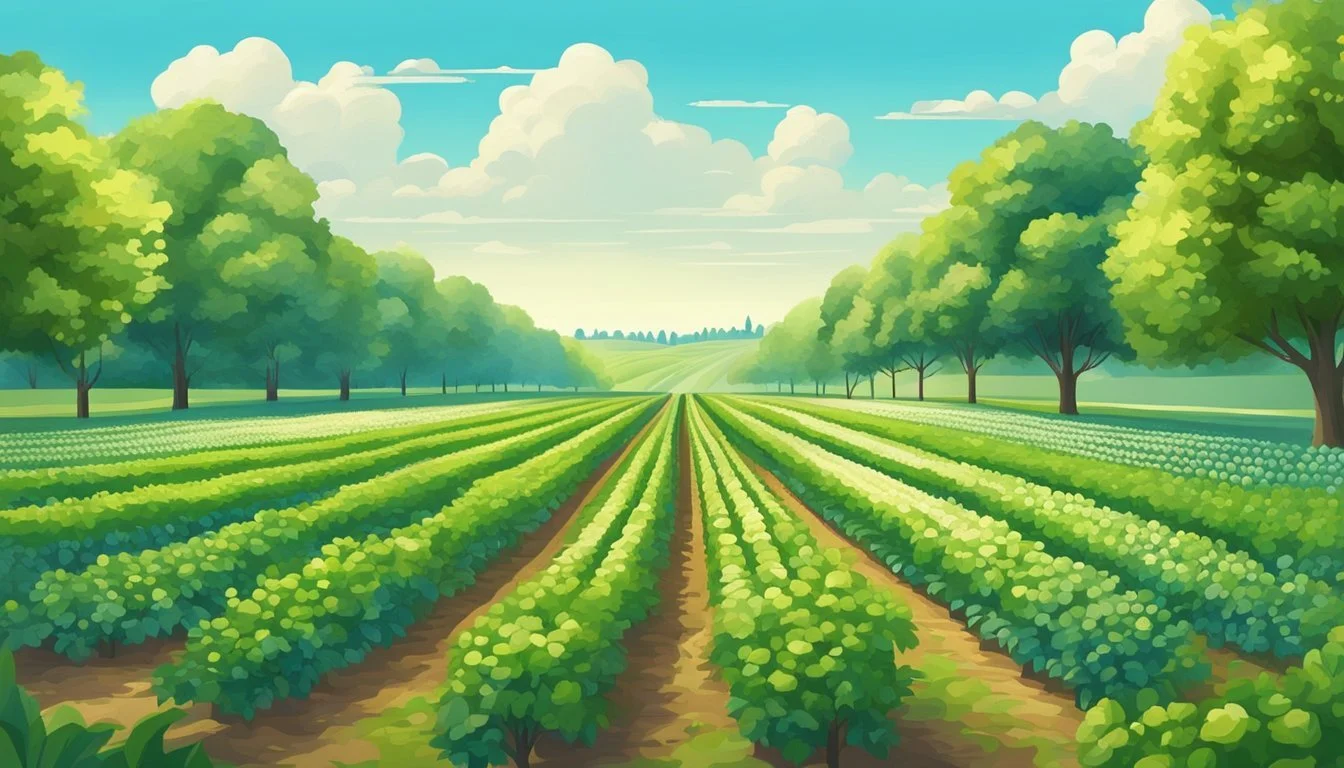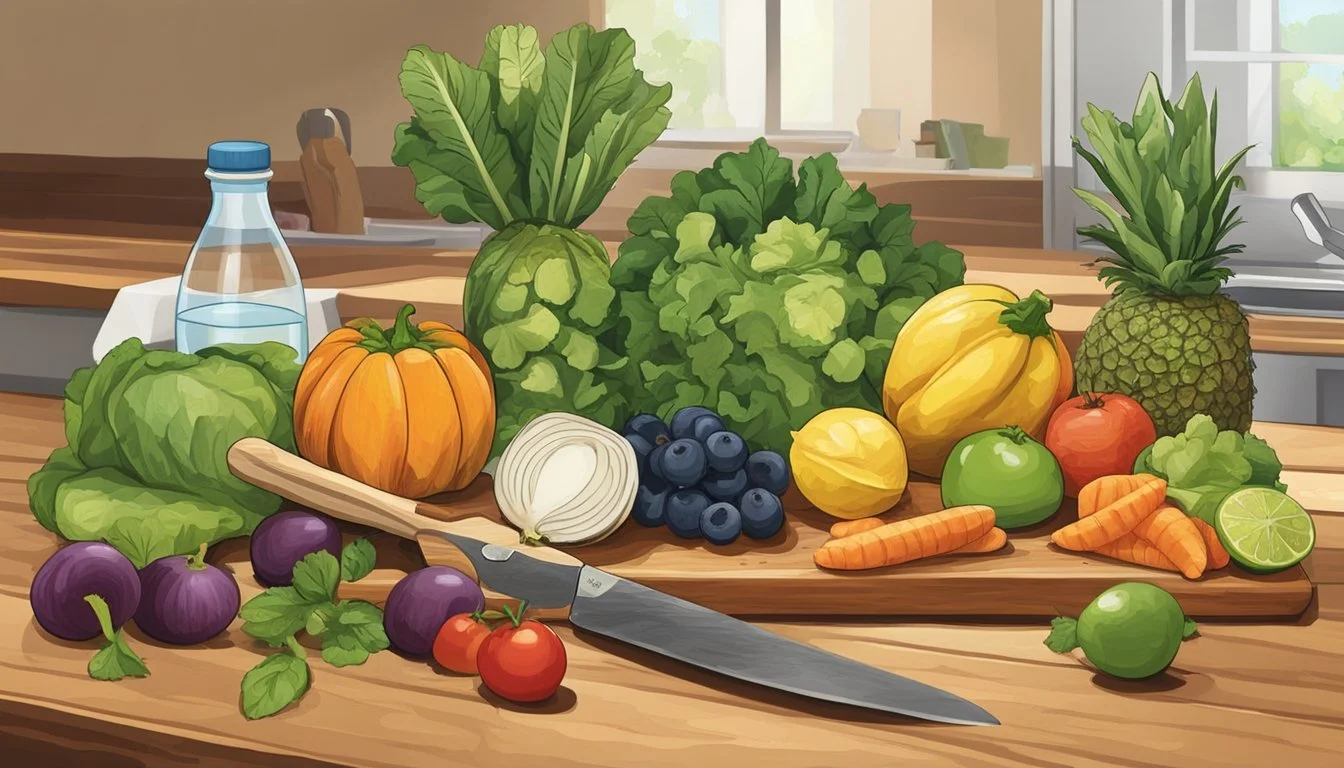Indiana Seasonal Fruit & Vegetables in April
Your Fresh Guide
This Article is Part of our Indiana Seasonal Fruit & Veg Calendar
In Indiana, April ushers in a season of renewal and fresh beginnings, particularly in the realm of agriculture. This is a period when local farmers and gardeners begin to reap the benefits of the cool spring climate that's conducive to growing a variety of seasonal produce. Consumers seeking farm-fresh fruits and vegetables will find that April offers a limited but distinct selection characterized by the hearty flavors and nourishing qualities of early spring crops.
As winter's grip loosens, April's seasonal produce highlights include leafy greens such as lettuce and spinach (What wine goes well with spinach?), which thrive in the cooler temperatures. These crops are among the first to be harvested in the spring and provide a wealth of vitamins and minerals. Root vegetables such as radishes, turnips, and the vibrant beets (how long do beets last?) also make their way to markets and dinner tables across the state, favored for their earthy flavors (What wine goes well with earthy flavors?) and nutritional value.
While fruit selections in April are not as abundant as in the summer months, Indiana sees the last of storage apples and prepares for the oncoming berry season. Strategic planning and crop selection are critical during this month, as Indiana's growers plant and nurture the seeds (how long do seeds last?) of crops that will mature in the warmer months ahead, ensuring a continuous supply of fresh, local produce throughout the year.
Benefits of Eating Seasonal Produce in Indiana
Freshness and Flavor: Seasonal produce is often fresher, having been harvested at the peak of its ripeness. This results in a richer flavor and more vibrant textures. For Indiana residents, springtime brings a bounty that is both diverse and palate-pleasing.
Availability and Markets: During April, Indiana markets are typically stocked with seasonal fruits and vegetables. Consumers benefit from the abundance, which often translates to lower prices and a broad selection of produce. Availability is at its peak, making it easy for individuals to incorporate a variety of fruits and vegetables into their diets.
Nutritional Value: Seasonal fruits and vegetables may offer better nutritional content due to the reduced time between harvest and consumption. Eating produce when it's in season means one can enjoy it when it's freshest and most nutrient-dense.
Typical Seasonal Produce in Indiana - April:
| Fruits | Vegetables |
|-------------|------------------|
| Strawberries| Spring Peas |
| Cherries | Radishes |
| Apples | Asparagus |
| | Green Onions |
Supporting Local Economy: By choosing seasonal, locally-grown produce, consumers support Indiana farmers and the local economy. Money spent at community markets circulates within the region, promoting sustainability and growth.
In conclusion, by eating seasonally in Indiana, individuals enjoy produce that is fresh, full of flavor, and nutritionally rich, all while supporting local markets and the economy.
April's Seasonal Vegetables in Indiana
In April, Indiana's vegetable offerings begin to diversify, providing an array of leafy greens, crisp root vegetables, and springtime favorites. Farmers' markets start to buzz with activity as the growing season takes hold, offering a variety of fresh produce to locals.
Leafy Greens and Herbs
Arugula, lettuce, spinach, and kale make their delightful appearance in Indiana during April, each adding a fresh, zesty flavor to any dish. These nutrient-rich greens are commonly found at markets and are versatile for a range of culinary uses. Adding to the mix, microgreens offer a concentrated burst of nutrients and flavor. Parsley and mint also begin to flourish, providing an aromatic freshness to springtime recipes.
Root Vegetables and Tubers
April's moist soil conditions are ideal for radishes and turnips, which deliver a peppery kick and a buttery smoothness respectively. Potatoes and beets are also hitting their stride, ready to be transformed into a variety of dishes that comfort and satiate.
Springtime Staples
Asparagus (What wine goes well with asparagus?) and peas peak in spring, becoming staples of the Indiana table. Their arrival is a sure sign of the season, and they are often celebrated in dishes that accentuate their fresh, earthy flavors.
Alliums in Bloom
As spring progresses, leeks, green onions, and scallions emerge, offering mild onion-like flavors that enhance salads and sautés. Onions and garlic continue to be essential kitchen ingredients, while garlic scapes provide a unique, mildly garlicky zest, perfect for inventive culinary creations.
Miscellaneous Vegetables
In the varied category of other vegetables, cabbage and cauliflower (how long does cauliflower last?) are also in abundance. Both are known for their versatility and are a hit in both raw salads and cooked dishes.
Fungal Bounty
Indiana's April moisture also heralds the mushroom season. Local markets start to showcase a variety of mushrooms, from the common button to more exotic varieties, all with distinctive flavors and textures that can transform any meal.
April's Seasonal Fruits in Indiana
April in Indiana brings a transition in the fruit offerings, with freshness and variety becoming available at local markets. This is a month where early berries make their appearance, promising the burst of flavor that comes with the heart of spring.
Emerging Berries
In April, strawberries start their season, although they tend to peak a bit later. Indiana residents can look for these first berries at farmer's markets, though they may not be in full abundance until May. The berries found in April are often especially flavorful, as the cooler spring weather can concentrate the sugars in the fruit. Those shopping for these fruits can expect strawberries that are smaller but packed with taste.
Despite the association of berries with summer, these early offerings are a delight for those eager for the taste of fresh, locally-sourced fruit.
Preparation and Cooking Tips for April Produce
April in Indiana brings a variety of fresh produce to the table. Utilizing herbs to enhance meals, employing specific cooking techniques for vegetables, and serving fruits at their peak can dramatically elevate everyday dining experiences.
Herb Usage and Pairings
April's harvest allows for the use of fresh herbs to bring out the flavors in seasonal dishes. Mint adds a refreshing touch to peas and compliments sweet strawberries in fruit salads or beverages. Parsley works well with potato dishes, offering a bright, earthy note that can elevate even the simplest of meals. For basil, consider pairing it with asparagus to add a subtle, sweet peppery essence.
Mint: Peas, Strawberries, Beverages
Parsley: Potatoes, Leek Dishes
Basil: Asparagus, Italian Cuisine
Vegetable Cooking Techniques
The tender asparagus of April is best when grilled or roasted to highlight its natural sweetness. Leeks, with their mild onion flavor, are essential in creamy Potato Leek Soup, and they should be carefully sautéed to bring out their best qualities. Peas are versatile and can be steamed to retain their crispness—perfect for side dishes or as an addition to pastas.
Asparagus: Grilled, Roasted
Leeks: Sautéed for soups
Peas: Steamed, added to pastas
Fruit Serving Suggestions
April brings strawberries forward, marking the start of a sweet season. When serving them, simplicity is key to savor their natural flavor. Strawberries can be sliced fresh into pies or eaten alone as a light dessert. Accented with a sprig of mint or a dollop of whipped cream, they make for an alluring and effortless treat.
Strawberries in pies: Fresh, Sliced
Strawberries as a dessert: Alone or with Mint, Whipped Cream
Storage and Preservation of April Produce
When dealing with April's seasonal produce in Indiana, maintaining freshness hinges on effective storage techniques. Early spring in Indiana offers a variety of cool-season crops such as peas, lettuce, spinach, carrots, beets, turnips, parsnips, and Swiss chard. Along with these, gardeners can transplant broccoli, cauliflower, cabbage, Brussels sprouts, kohlrabi, and onions.
For optimal freshness, leafy greens like lettuce and spinach should be washed, dried, and stored in the refrigerator's crisper drawer in airtight containers lined with paper towels. Root vegetables such as carrots, beets, and turnips are best kept in a cool, dark place and can be stored in the refrigerator or a root cellar for extended freshness. Carrots and beets may last several weeks, whereas turnips can maintain their quality for about two weeks.
When storing asparagus, it should be treated like a bouquet of flowers – the stalks can be kept upright in a container with a small amount of water to maintain their firmness. For rhubarb, remove any leaves (which are toxic), and store the stalks wrapped in plastic in the refrigerator.
Below is a brief table on storage methods:
Vegetable Storage Method Peas Refrigerate in a bag; use within a week Lettuce Wash, dry, and refrigerate in a container Spinach Refrigerate in a plastic bag with paper towel Root Vegetables (carrots, beets, etc.) Keep in a cool place; refrigerate to extend freshness Broccoli/Cauliflower Refrigerate; store in a perforated bag
For those seeking to preserve the April harvest, blanching and freezing are reliable options for peas, spinach, and broccoli which can extend their availability. It is imperative to blanch these vegetables prior to freezing to preserve their texture and nutritional quality. The proper blanching time varies: peas require 1-2 minutes, spinach 2 minutes, and broccoli 3 minutes, followed by immediate cooling in ice water to stop the cooking process before freezing.
In summary, adequate storage can significantly enhance the shelf life and quality of Indiana’s April produce, ensuring that the flavors of early spring can be enjoyed even beyond their natural season.
Where to Find Seasonal Produce
When seeking the freshest April produce in Indiana, one can explore various avenues such as local farmers markets, Indiana's food maps, and community-supported agriculture programs. Each presents a unique opportunity to access a variety of seasonal offerings.
Local Farmers Markets
Farmers markets across Indiana become vibrant hubs in April, offering a bounty of seasonal produce direct from local growers. Availability varies as these markets may operate on specific days of the week, but they usually provide a wide range of fruits and vegetables. Shoppers are encouraged to visit early for the best selection.
Indianapolis City Market: Open select days, featuring produce from surrounding farms.
Bloomington Community Farmers' Market: A bustling Saturday market showcasing local produce.
Indiana's Food Map
Indiana's food map provides a visual and interactive tool to locate fresh, seasonal produce. This resource can guide shoppers to:
Nearby farms: Finding farms that sell directly to the public.
Markets: Identifying a variety of farmers markets across the state.
Utilizing the map ensures that consumers can find current information on availability and plan their purchases accordingly.
Community Supported Agriculture
Community-supported agriculture (CSA) is an increasingly popular way for consumers in Indiana to buy seasonal food directly from local farmers. By purchasing a share at the beginning of the growing season, members receive a regular supply of fresh produce, which in April may include:
Greens: Such as lettuce or spinach, often available early in the spring.
Herbs: Aromatic selections becoming available as the weather warms.
CSAs work on a subscription basis and typically offer pick-up locations or delivery options for added convenience.
Growing Your Own April Produce in Indiana
April in Indiana provides a unique opportunity for gardeners to begin planting a variety of cool-season crops that thrive in the spring's mild temperatures.
Gardening Tips for Spring
Spring gardening in Indiana means preparing for a limited window between the last hard frost and the onset of hotter summer temperatures. Gardeners should test soil for nutrient levels and drainage, ensuring conditions are optimal for new growth. It's also essential to ready planting beds by clearing away winter debris, loosening the soil, and adding compost for nutrients. Using mulch can help maintain soil moisture and temperature, as well as suppress weeds that compete with crops.
Seasonal Planting Guide
In April, Indiana gardeners can plant a variety of cool-season vegetables that can withstand the still-chilly nights. Recommended plants include:
Potatoes: Plant seed potatoes after the danger of frost has passed, typically in early to mid-April.
Asparagus: Although asparagus crowns are best planted when the soil can be worked in March, young asparagus plants can still be established in April.
Greens: Various greens such as lettuce, spinach, and kale can be directly seeded into the garden in April.
Vegetables Planting Method Notes Potatoes Seed potatoes Plant 2-3 inches deep, in rows 12 inches apart. Asparagus Crowns/young plants Choose well-drained soil. Lettuce Direct seed Plant in partial shade to prevent bolting. Spinach Direct seed Enrich soil with compost before planting. Kale Direct seed/transplants Tolerant to a light frost.
Regular watering and weeding are crucial for these crops, especially as they establish. Gardeners should also be prepared to cover young plants in case of an unexpected late frost to protect their investments.
Environmental Impact of Seasonal Eating
Eating seasonally entails consuming fruits and vegetables that are currently being harvested locally. In Indiana, this practice is particularly pertinent in April, when the onset of spring offers a variety of such produce. Choosing seasonal items can reduce the need for long-distance transportation, a process typically involving the burning of fossil fuels which contributes to greenhouse gas emissions.
Seasonal Produce: Indiana's April offerings often include asparagus, radishes, and spring greens. Locally harvested, these items reach consumers quickly, ensuring freshness and reducing the carbon footprint associated with their distribution.
Eco-Friendly Practices: By purchasing produce in-season, consumers support farming practices that align with the natural growing cycles and local ecosystem, potentially reducing the need for artificial heating, lighting, and excessive water usage — factors that contribute to environmental strain.
Consumer Choices & Local Economy: When Indiana residents opt for seasonal produce, they also invest in the local economy. Localized purchasing reduces supply chain lengths, minimizing the ecological impact of logistics while bolstering community agriculture.
In summary, the impact of choosing to consume seasonally extends beyond personal health benefits. It is an eco-friendly choice that supports sustainability. Choosing seasonal and local produce in Indiana can contribute to a reduction in the environmental impact of agriculture, affirming the connection between dietary habits and ecological well-being.
Economic Benefits of Supporting Local Farms
In Indiana, local farms are integral to the state's economy. Supporting these establishments significantly benefits both the agricultural community and the wider regional markets. When consumers purchase directly from farmers markets, they help to sustain the livelihoods of local growers and contribute to the state's financial health.
Increased Revenue for Local Farms: Smaller farms, particularly those yielding fruit and vegetables, find greater financial success through regional markets. Direct sales at farmers markets can boost a farm's gross annual revenue, especially for those earning under $350,000 a year.
Job Creation: Investment in local agriculture translates to job creation within the community. By prioritizing local produce, the demand for a workforce to grow, harvest, and sell the fresh goods increases.
Strengthening the Local Economy:
Every dollar spent at a local farmers market has a multiplier effect, circulating within the state and stimulating economic growth.
Local farms are more likely to purchase their supplies from other local businesses, thus keeping the money within the community.
Sustainability and Reduced Transportation Costs: By minimizing the distance food travels from farm to consumer, Indiana lowers its overall transportation costs. This not only supports local farms but also reduces the environmental impact, aligning with broader sustainability goals.
In summary, fostering local farms through direct market channels cultivates a resilient economic framework in Indiana. It supports the preservation of small-scale farms while reinforcing a locally-driven food system, making it a win-win for producers and consumers alike.











